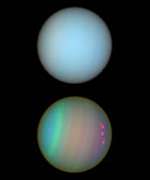
Image credit: Hubble
New photographs from the Hubble Space Telescope show details of the atmospheres on Uranus and Neptune. The photos were taken using Hubble’s Imaging Spectrograph and Advanced Camera for Surveys in August 2003. Both planets have bands of clouds and haze lined up with the planets’ equators. Astronomers use different kinds of filters to reveal different kinds of gasses in the clouds, and even their altitudes above the planets.
Atmospheric features on Uranus and Neptune are revealed in images taken with the Space Telescope Imaging Spectrograph and the Advanced Camera for Surveys aboard NASA’s Hubble Space Telescope. The observations were taken in August 2003.
The top row reveals Uranus and Neptune in natural colors, showing the planets as they would appear if we could see them through a telescope. The images are made of exposures taken with filters sensitive to red, green, and blue light. In the bottom images, astronomers used different color filters to detect features we can’t see. The photographs demonstrate that, by using certain types of color filters, astronomers can extract more information about a celestial object than our eyes normally can see.
At first glance, the top row of images makes the planets appear like twins. But the bottom row reveals that Uranus and Neptune are two different worlds. Uranus’s rotational axis, for example, is tilted almost 90 degrees to Neptune’s axis. The south poles of Uranus and Neptune are at the left and bottom, respectively. Both are tilted slightly toward Earth. Uranus also displays more contrast between both hemispheres. This may be caused by its extreme seasons.
Both planets display a banding structure of clouds and hazes aligned parallel to the equator. Additionally, a few discrete cloud features appear bright orange or red. The color is due to methane absorption in the red part of the spectrum. Methane is third in abundance in the atmospheres of Uranus and Neptune after hydrogen and helium, which are both transparent. Colors in the bands correspond to variations in the altitude and thickness of hazes and clouds. The colors allow scientists to measure the altitudes of clouds from far away.
Original Source: Hubble News Release

kool man this is awsome
Heyy
this website is totaly rockin man
xoxoxoxo